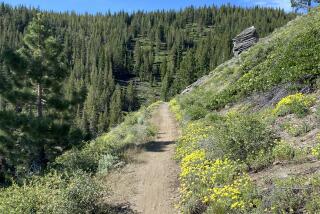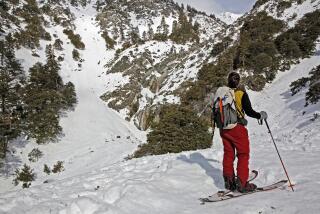Pikes Peak, Colorado: It’s all about the journey and views
Pikes Peak has a punctuation problem.
The mountain outside Colorado Springs is named for Zebulon Pike, the explorer who in 1806 was dispatched by President Jefferson to chart the region.
Even though almost everyone omits the apostrophe, Pike’s is grammatically correct. However, over the years, trailblazers and entrepreneurs have struggled with a much bigger problem: how to reach the summit.
Turned back by a snowstorm, Pike never made it to the top of the 14,115-foot peak. Early ascents by mule were grueling two-day affairs.
Things changed more than a century ago. On June 20, 1891, a church choir from Denver became the first group to reach the top by passenger train. They traveled aboard a unique railway propelled by a series of cogs, or gears, that made possible extremely steep climbs.
“It’s all about your coefficient of friction,” said Spencer Wren Jr., general manager of the Manitou & Pike’s Peak Railway Co.
“If it gets too steep and you don’t have enough friction, you’re going to slip,” he said of the cog railway’s ability to handle 25% grades. On such stretches, the train climbs 25 feet in altitude for each 100 feet of track.
Conductors point out various wildlife along the 70-minute trip to the top. For the first third of the nine-mile ride, the train follows a cascading creek through dense stands of evergreens. At 12,000 feet — the timberline — the landscape suddenly changes to a surreal, rocky terrain devoid of all but a few hardy plants.
At the summit a young boy — bundled up against the chill on an overcast summer afternoon — pointed as he exclaimed, “I think I can see another state from here!”
No, his grandfather said, that’s Colorado Springs, 8,000 feet below in the valley. On a clear day, however, folks can make out the skyscrapers of downtown Denver more than 70 miles away.
A mere 10 years after the railroad’s completion, the first car climbed Pikes Peak. On Aug. 12, 1901, two men made the journey along a gravel track in a two-cylinder Locomobile Steamer.
In 1916, a $2-per-person toll to use the road was levied. Now it costs $12 a head, a pittance to pay for the opportunity to explore the mountain independently along the 38-mile round trip.
Train passengers have about 40 minutes at the summit to snap pictures, grab a bite to eat and buy a souvenir. Those who come by car stay about the same length of time, because they often find themselves becoming short of breath in the thin air.
It’s the downhill journey that provides real thrills for those in their own vehicles. Frequent signs remind drivers of the 10 mph speed limit and to use first gear. Cocky motorists who keep the transmission in drive soon find themselves downshifting at the steep hairpin turns.
“You’ve been using first gear. Your brake temperature is only 100 degrees,” a ranger compliments a driver at the mandatory checkpoint outside the Glen Cove Inn, about 2,700 feet below the summit.
Drivers who’ve been riding their brakes, causing them to overheat, are forced to park for at least 30 minutes while they cool. Such a wait allows people another opportunity to get something to eat or to shop for souvenirs, including a life-sized replica of the bighorn sheep that live on the mountain.
More to Read
Sign up for The Wild
We’ll help you find the best places to hike, bike and run, as well as the perfect silent spots for meditation and yoga.
You may occasionally receive promotional content from the Los Angeles Times.





